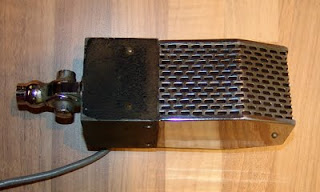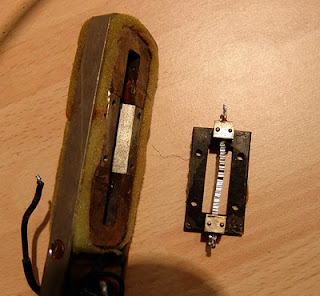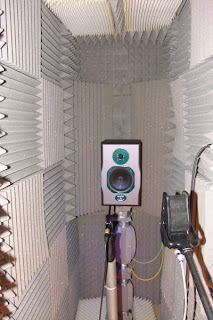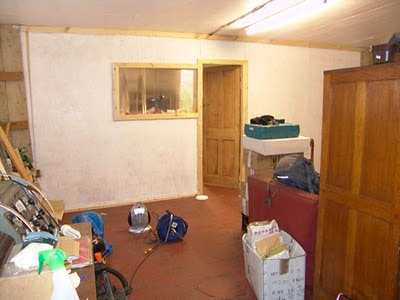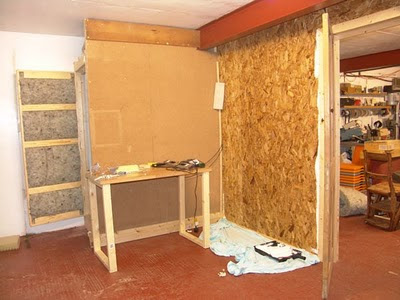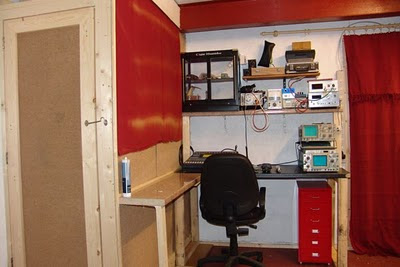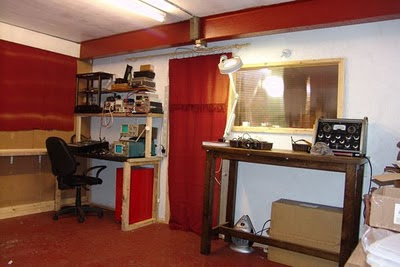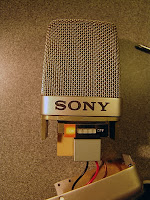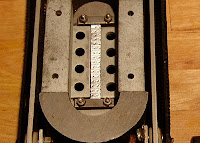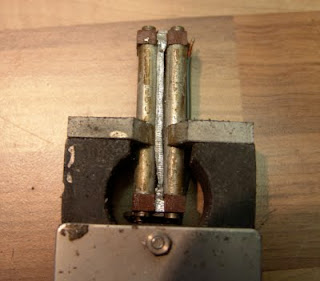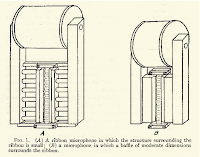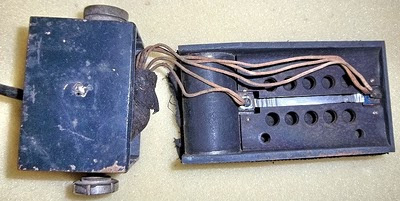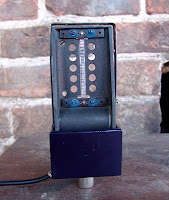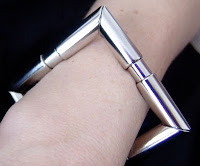I love Czech!
The Xaudia Blog
MOTM: Shaftesbury Velodyne Supreme

As you may know, I study quite a lot of vintage ribbon microphones. In general these are simple devices, with just a ribbon, motor, magnets and output transformer . The details and quality of the parts may vary, but most have the same mode of operation. But just once in a while something surprising comes along. Like this Shaftesbury Velodyne Supreme microphone, which is a ribbon microphone with a twist.
The output of a ribbon mic will scale in proportion to the length of the ribbon, at least up to a point. The idea behind the Velodyne was to give increased output by using a super-long ribbon. Normally that wouldn’t give you as high an output as it should, because of ‘rippling’, or other incoherent vibrational modes. But by fixing the ribbon in multiple places they claim to avoid this problem. The microphone was sufficiently novel at the time for the inventors to apply for protection.
Well that’s the theory. In practice the microphone has one giant ribbon that goes round corners, and each length of ribbon has a ‘node’ in the middle, so in total it has 8 elements, each at 45 mm x 4 mm. So 360 mm of vibrating ribbon!
What is more, the microphone has no transformer! I guess the designer thought it had enough impedance already and did not need one.
I wonder how well it worked? Sadly we may never know. The ribbon is broken in many places, and is glued down, so it will net be an easy thing to replace. I’m still struggling over whether to try and get this working or not. I suspect it really ought to be left in its historic condition, but I am curious about how it would have sounded.
Postscript: History shows that this design was not a success. Whether this was for sonic or economic reasons, we can only speculate, but Shaftesbury appear to have abandoned the concept. Their later ribbon microphones were a much more conventional affair, like this Shaftesbury RT model – ribbon, magnets and transformer.
Mic of the Month – Zephyr 30RA high impedance ribbon mic
February’s MOTM is a ribbon microphone made by Zephyr, of Australia. It’s nice to see a microphone that begins with the letter Z!
The mic has a very “retro sci-fi” look, with hammerite paint and a punched metal grill. The name plate reads “High fidelity velocity microphone type 30RA, but despite the misleading model number, the mic is actually a high impedance mode, and the output transformer is marked “50K’.
The magnets are still healthy on this one, kicking out around 2500 Gauss between the pole pieces. The ribbon is 2.5 mm wide and 28 mm long, similar in scale to a Reslo RBL or Grampian microphone.
The back of the ribbon element is covered in lots of felt, to stop air blasts and brighten the mic for vocal use. Removing some of this opens the sound up a bit. This beast was probably intended for use with a home tape recorder, and would have worked very nicely in that application.
The ribbon itself is mounted on a removable plastic saddle, which makes servicing very simple. Which is a good thing, because this one is stretched. This idea is also seen on Reslo and other microphones.
With a new ribbon, and a suitable impedance-matching buffer, the microphone sounds rich and full – well worth the time spent to get it up and running again.
Update October 2025: The RA 30 appears in a Zephyr Advert from July 1958, which was published in Radio, Television & Hobbies magazine.
New workshop part 2: Construction Time Again
After a morning with glue and a staple gun, sticking acoustic foam to the soft walls, our new microphone testing chamber is up and running. Here are a couple of photos….
The chamber is hooked up to pink noise and swept-sine equipment, and can collect a frequency plot in a matter of seconds. I’m still working on validation, testing different speakers and mics for best performance, but the facility is already proving its worth.
New workshop! (part 1)
It’s been a quiet month so far for blogging, but a busy one at Xaudia.
We’ve spend the last week building a new microphone workshop in the basement below the studio, including an ‘anechoic’ isolation booth for mic testing. Ralph & Jane have been helping out with building and painting.
Here’s the empty room, waiting to realise its potential:
Wall going up…
A door, window and a slap of paint
Isolation booth and test and measurement area…
And with the test gear going in:
The door on the left is an isolation / semi-anechoic box for testing mics or punishing drummers. The sound treatment is on order.
Anyway, loads left to do….
Thread Adapters for RCA, Sony and other microphones
 |
| RCA to modern mic stand thread adapter |
A few months ago I was trying to find some thread adapters for a customer with an old RCA junior ribbon microphone, who wanted to use it with a modern standard 5/8″ microphone stand. Most suppliers were charging around $25 dollars, plus post and the inevitable import and handling duties.
So we decided to make some.
These fit most of the ‘big’ vintage RCA microphones, including the 44, 74b and 77 ranges, and also are perfect for Sony professional mics, including the C38b, FV300 and C48 microphones. They also fit Syncron AU7A / Fairchild F22 microphones, and several other American and Japanese microphones with a large thread.
Update:
These are now for sale on the Xaudia website priced at £6.00.
If you want one, please get in touch.
Mic Of The Month: Sony F-V300 Dynamic microphone
 |
| Sony F-V300 and C38b microphones |
This unusual Sony microphone (left) looks like the younger brother of a C38b (right) or maybe a C48 condenser mic, and shares the same high build quality and some hardware components with these mics. But in actual fact this is a high quality cardioid pattern dynamic microphone, model F-V300.
Inside, the microphone is very simple, with just a capsule in the top compartment, and the on/off switch and transformer wired to a printed circuit board below. The fixed grey output cable looks to be the same type as found on the C38b.
The capsule is suspended from 8 small springs to act as an internal shockmount, which seems to work well, in conjunction with the yoke, to acoustically decouple the microphone element.
This example has some traces of foam around the element, indicating that an internal windshield has at some time been removed.
The label states that the mic is nominally of 1kΩ impedance, although in practice seems lower than this and it has no problems driving standard low-Z microphone preamps. The output is strong and clear across the range, and the output is similar in level and detail to a healthy EV RE20, although with a more pronounced proximity effect.
As far as we know, this microphone was only marketed in Japan, but if you have any information to confirm or deny this, or in fact any information about this mic at all, please let us know!
UPDATE 22/2/11
This microphone has become a bit of a favourite for guitar cabs – it seems to have just the right amount of proximity boost for that application, giving clear and solid presence to the lower end. It also makes a decent tom mic.
Strange things you find inside ribbon mics (part 1)
Microphone ribbons are generally made from very thin metal foil, and aluminium is the ideal material as it is very light but also very conductive. The output of the microphone is inversely proportional to mass, and so a thicker, heavier ribbon will give a lower output, and a thin light ribbon will be more sensitive. Many manufacturers use something typically around 0.0001 inch or 2 microns in thickness. The ribbon is also typically corrugated either along the full length to prevent lateral motion, or at the ends to give a ‘piston’ style of ribbon. Well, that is how it should be.
However, ultra-thin aluminium is hard to get hold of, and the non-specialist may be tempted to make repairs using materials that are more readily available. Here are some things I have found inside microphones masquerading as ribbons – needless to say they were all replaced with good quality aluminium foil of an appropriate thickness!
1. Cigarette Paper.
This microphone actually worked, to an extent! It at least made a sound. The ribbon was made from an old fag packet.
Cigarette packs used to come lined with paper-backed foil – I’ve never been a smoker so I don’t really know why, but I imagine for freshness or something. The foil is thin and already textured – it just needs to be separated from the paper. Actually this last part seems to be optional, and sometimes bits of paper are still attached, making the ribbon heavy and noisy.
1.b I’ve heard that chewing gum wrappers were also used for redneck ribbons, if you want a minty fresh microphone.
1.c Here’s a lovely example of cigarette paper being used for a ribbon in an old GEC microphone.
2. Kitchen Foil
Kitchen foil is easy to handle, yet much too thick to make a decent ribbon. But that doesn’t stop people trying. This is a common ebay trick… the ribbon looks in good condition, but when the mic arrives the output is low and sounds crunchy.
3. Sweet Wrappers
Plastic coated foil or metallised plastic, like that found in sweet wrappers is an interesting innovation, but is generally too heavy and has too high a resistance to make a decent ribbon. Also the plastic doesn’t conduct. This microphone gave almost no signal, and it isn’t hard to see why.
Microphone of the Month – Philips Ribbon Mic
This old microphone by Philips came from a seller in Egypt – I have a vision of it being used back in the 1940s and 50’s, broadcasting out in the desert, near the Pyramids and Sphinx….
The mic was in pretty bad shape and in need of a full restoration. The ribbon was broken, and it was missing a yoke and several other parts. However, it’s a pretty interesting microphone and so gets to be our microphone of the month for December.
This microphone appears to be based closely on Harry F. Olson’s drawings in early patents and presented in the Journal of the Society of Motion Picture Engineers, back in 1931.
The magnetic field is provided by one large permanent barrel magnet. This microphone had a measured field of about 1200 Gauss between the poles, with ribbon dimensions of 5.5 mm wide by 67 mm long.
The original ribbon – sadly very oxidised – was of the piston type, with corrugations at each end and a flat section in the middle region. On closer inspection, the ribbon appears to have been designed for in-field replacement: each end is terminated in a thicker, silver-plated fold of foil, with a hole drilled for ‘easy’ mounting (easy being a relative term in this case). The ribbon is held in place with two brass clamps, each mounted held in place with a singe screw. The disadvantage of using a single screw rather than a pair for the ribbon clamps is that the clamp has a tendency to rotate as it is tightened, which can distort or wreck the ribbon. The clamps are soldered to wires which run to the transformer primary, and these wires are doubled (or tripled) in each case, presumably to keep resistance noise to a minimum.
With a rewire and a new (corrugated) ribbon the microphone works and sounds rather full and rich. However, the output transformer is wound for high impedance output, and won’t drive a standard mic preamp – so the microphone benefits from using an active buffer or an impedance matching transformer. Hum is also an issue with this, despite the massive brass housing.
I haven’t seen another one like this – either in life or on the web. If you have any further information on this, I’d love to hear from you.
Fun with magnets and an Electrovoice V1 velocity ribbon mic
Here’s an early Electrovoice velocity ribbon mic, model V1. These are great looking microphones, but the early versions are rather crudely made and this one, like many others, suffered from low output due to weakened magnets.
Bob Crowley has a few things to say about these mics – not all of them nice!
The motor of this model is based on a single cylindrical permanent magnet, clamped to a pair of metal plates which make up the pole pieces of the assembly. Because of the positioning of the magnet, the magnetic field is uneven, with a significant difference in field between the top and bottom of the motor assembly. In our example we found that the field varied from around 700 gauss at the bottom to 1000 gauss at the strongest point. This is very low for a ribbon mic, and, along with the oxidised ribbon is responsible for a low, noisy output.
Fortunately, we have sourced some very powerful cylindrical N42 neodynium magnets of a suitable size and shape, which are a perfect replacement for the original weak magnet.
With the new magnet the field is increased by a factor of around four, to about 3000-3200 gauss, a much healthier figure which should lead to an increased output and much improved signal-to-noise performance.
Now it’s time to cut a new ribbon, reassemble the microphone, and do some listening tests. In the meantime, we made a rather attractive bracelet from some of the spare magnets.




